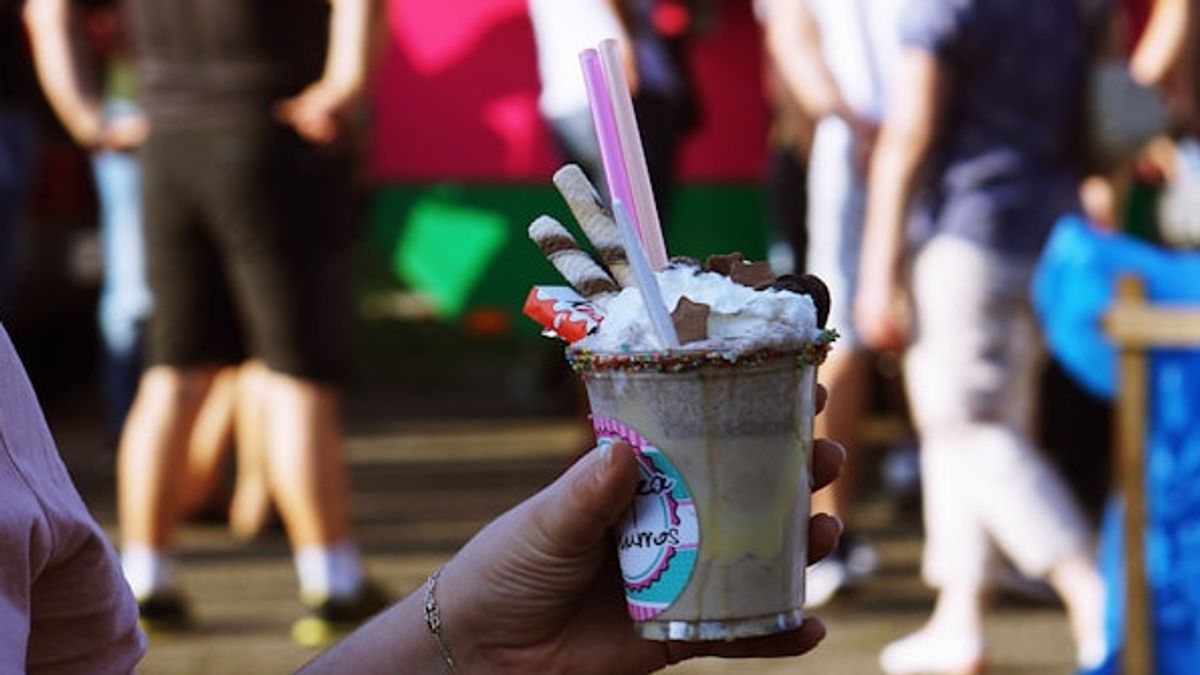JAKARTA Foods and sweet drinks that are consumed excessively have an impact not only on physical health, but also on mental health.
Lately, the bad effects of eating sweet foods and drinks have continued to be in the spotlight. Citing Care, most sweet foods or drinks can increase the risk of serious health problems. Among these impacts are obesity, diabetes, heart disease, cavities, and uric acid.
Not only that, in the midst of the proliferation of contemporary sweet foods and drinks that often go viral, it also increases the risk of early death from non-communicable diseases such as heart attacks and several types of cancer.
Research published by Harvard University's TH Chan School of Public Health in March 2019, which analyzed data from 37 thousand men and 80 thousand women over 30 years, found that the more sugary drinks a person consumes, the greater the risk of early death for that person.
"Compared to people who drink less than one sweet drink per month, drinking one to four sweet drinks a month increases the risk by one percent. Drinking two to six per week, the risk increases by six percent. One to two sweet drinks per day, the risk is 14 percent. As for two or more drinks, the risk is 21 percent, "said Vasanti Malik, scientist from Harvard's Department of Nutrition and lead author at the study.
Eating excessive sweet foods and drinks does not only affect physical health, but also has a negative impact on mental health.
According to several studies, excessive sugar consumption, plus fast food consumption, can trigger stress, depression, and the desire to commit suicide, especially among teenagers.
One of them is the scientific journal Frontiers in Nutrition in 2022 written by Jin Suk Ra. In the journal, it highlights the relationship between the consumption of sweetened drinks or the suggestions of beverages (SSB) and fast food, with mental health among adolescents in South Korea (South Korea).
"In South Korean teenagers, combining the consumption of sugary sugary drinks and fast food above the average is associated with more stress, symptoms of depression, and the desire to commit suicide," the study said.
The study was conducted by analyzing secondary data of more than 24 thousand high school students in South Korea, based on the results of the 17th Korean Youth Behavior Risk Web-Based Survey in 2021.
Likewise with Lu Zhang's scientific articles, Haiyang Sun, Zihui Liu, Jiguo Yang, and Yuanxiang Liu, published in February 2024. This article highlights the relationship between sugar consumption and depressive levels.
"We found that the increase in food sugar intake by 100 grams per day correlates with the prevalence of depression which is 28 percent higher," the article wrote.
The study involved 18,439 adults or over 20 years from the United States National Health and Nutrition Examination Survey from 2011 to 2018.
What about Indonesia?
Problems with depression and mental health have recently become a concern in Indonesia. The Ministry of Health (Kemenkes) through the 2023 Indonesian Health Survey (SKI) has mapped the prevalence of depression in the population over 15 years. The prevalence of depression in people over 15 years, in the last two weeks, is 1.4 percent of the respondents' data.
However, when examined more deeply according to the age group, SKI data shows that the higher prevalence of depression is actually in the youngest age group, namely the age range of 15-24 years and the oldest group, namely 65-74 years and 75 years and over.
"In the 15-24 year age group, the prevalence reaches two percent," said the SKI report.
However, it should be noted that the 2023 SKI does not associate the problem of depression with the consumption of sweet foods or drinks. But the same survey shows the high consumption of sweet foods and drinks among the people of Indonesia.
The majority of Indonesians, to be precise 56.2 percent, eat sweet foods 1-6 times a week on average. In fact, about 1 in 3 Indonesians (33.7 percent) eat sweet foods more than once a day.
Likewise with the consumption of sweet drinks. A total of 47.5 percent of respondents admitted to drinking sweet drinks more than once a day, while another 43.3 percent drank sweet drinks 1-6 times a week.
Those that include sweet foods based on the classification of SKI 2023 are foods that contain high sugar, including sticky ones. Meanwhile, mamnis drinks are those that contain high sugar, but are different from carbonated drinks.
SKI 2023 includes the category of sweet foods and drinks in the category of foods that are at risk of degenerative diseases such as coronatric heart, hypertension, diabetes mellitus, and cancer.
In contrast to South Korea and the US, which have conducted research on the relationship between food consumption and sugary drinks with depression levels, in Indonesia there has actually been no comprehensive research that can show the correlation between these two things.
But a clinical psychologist from Ohana Space, Rafika Syaiful M.Psi., explained the connection between excess sugar consumption and mental health. According to Rafika, obesity due to excess sugar consumption has the potential to cause a lack of confidence in sufferers.
"When people are obese, there must be a sense of inferiority, there is a lack of comfort with themselves. In the end, it can also lead to anxiety, it can also lead to depression," said Rafika.
Furthermore, Rafika also highlighted the habit of people who generally eat sweet foods and drinks to relieve stress.
SEE ALSO:
Even though excessive consumption of sweet foods and drinks in the long term can activate the Hyphalamic Situitary Adrenal Axis or HPA Axis (a small structure in the brain and the size of a walnut). HPA Axis is connected to the central nervous system and the endocrine system. They work together to regulate hormonal balance in the body and affect the stress response.
Stress responses refer to how the body reacts to stress events, including an increase in heart rate or sweat.
Simply put, when you eat too often food and sweet drinks, which affect HPA, a person will feel stressed, then overcome these feelings with sugar. According to Rafika, this kind of pattern is like a vicious circle.
The English, Chinese, Japanese, Arabic, and French versions are automatically generated by the AI. So there may still be inaccuracies in translating, please always see Indonesian as our main language. (system supported by DigitalSiber.id)













